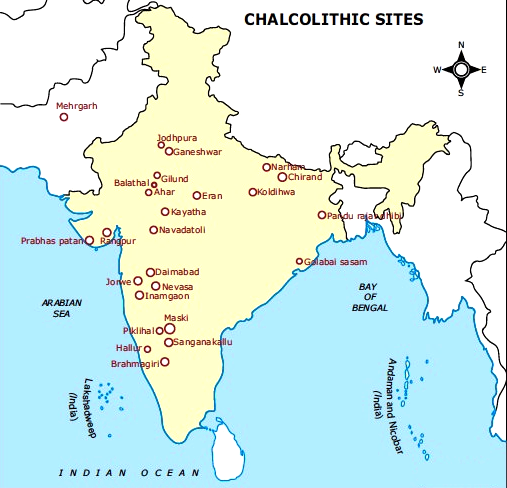Indian History
Chalcolithic Culture in Central India
- 18 Dec 2021
- 5 min read
For Prelims: Archaeological Survey of India (ASI), Chalcolithic Culture, Harappa culture.
For Mains: Chalcolithic Culture and its characteristics, Chalcolithic sites in India.
Why in News
Recently, Archaeological Survey of India (ASI) carried out excavations at two prominent sites of Chalcolithic affiliations in Central India (Eran, district Sagar and at Tewar, district Jabalpur) in the state of Madhya Pradesh.
Key Points
- Chalcolithic Culture:
- About: The end of the Neolithic period saw the use of metals. Several cultures were based on the use of copper and stone implements.
- Such a culture is called Chalcolithic and as the name indicates, during the Chalcolithic (Chalco = Copper and Lithic = Stone) period, both metal and stone were utilised for the manufacture of the equipment in day-to-day life.
- The Chalcolithic cultures followed the Bronze Age Harappa culture.
- It spanned around 2500 BC to 700 BC.
- Salient Features: The Chalcolithic culture of a region was defined according to certain salient features seen in ceramics and other cultural equipment like copper artefacts, beads of semi-precious stones, stone tools and terracotta figurines.
- Characteristics:
- Rural Settlements: The people were mostly rural and lived near hills and rivers.
- The people of Chalcolithic Age survived on hunting, fishing, and farming
- Regional Differences: Regional differences in social structure, cereals and pottery become visible.
- Migration: Migration and diffusion of population groups were often cited as causes for the origin of different cultures within the Chalcolithic period.
- First Metal Age of India: Since this was the first metal age, copper and its alloy bronze which melt at low temperature were used for the manufacture of various objects during this period.
- Art and Craft: The specialty of the Chalcolithic culture was wheel made pottery mostly of red and orange colour.
- Different types of pottery were used by the people of the Chalcolithic phase. The Black-and-Red pottery among them was quite common.
- The Ochre-Coloured Pottery(OCP) was also in use.
- Rural Settlements: The people were mostly rural and lived near hills and rivers.
- About: The end of the Neolithic period saw the use of metals. Several cultures were based on the use of copper and stone implements.
- Excavation at Eran during 2020-21:
- Eran (ancient Airikina) is situated on the left bank of the Bina (ancient Venva) river and surrounded by it on three sides.
- Bina river is a river that flows in Madhya Pradesh state of India. It is a chief tributary of the Betwa river, which is itself a tributary of the Yamuna river.
- Eran is located 75 km north-west from Sagar district headquarter.
- The recent excavation at this site, during 2020-21, has unearthed a variety of antiquities including a copper coin, an iron arrowhead, terracotta bead, stone beads along with a copper coins, stone celt, beads of steatite and jasper, glass, carnelian, terracotta wheel, animal figurines, miniature pots, iron objects, stone querns, pestles and a red slipped terracotta with inscription in Devnagari.
- The occurrence of few specimens of plain, thin grey ware is noteworthy.
- The use of iron was evidenced by few metallic objects at the site.
- This excavation at the site also revealed the remains of Chalcolithic culture with four major periods i.e.
- Period I: Chalcolithic (18th -7th BCE),
- Period II: Early historic (7th– 2nd century BCE & 2nd century BCE – 1st century CE),
- Period III: 1st – 6th century CE
- Period IV: late mediaeval (16th – 18th century CE).
- Eran (ancient Airikina) is situated on the left bank of the Bina (ancient Venva) river and surrounded by it on three sides.
- Excavation at Tewar during 2020-21:
- Tewar (Tripuri) village is located 12 km west of Jabalpur district on Jabalpur – Bhopal highway.
- This excavation revealed four folds of cultural sequences i.e. Kushana, Shunga, Satavahana, and Kalachuri.
- Antiquarian remains in this excavation include viz remains of sculptures, hopscotch, terracotta balls, Iron nails, copper coins, terracotta beads, implements of Iron and terracotta figurine, in ceramics red ware, black ware, red slipped ware with shapes of handi, bowl, spouted pot, small pot, big jar, etc., structural remains consist of brick wall and structure of sandstone columns.







